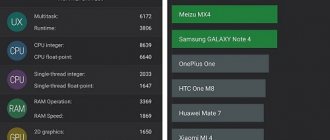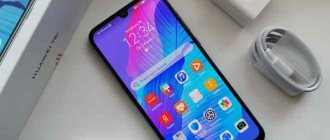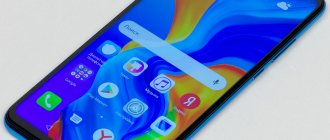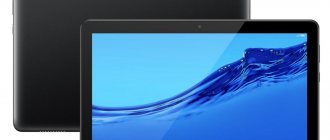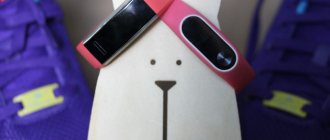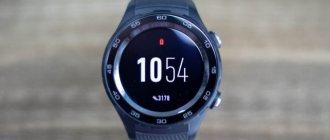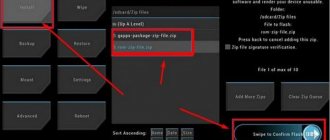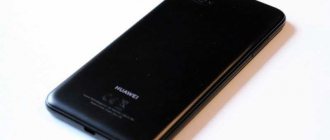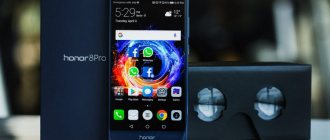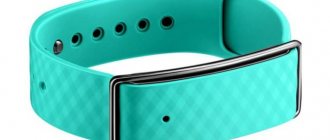Specifications of Huawei Y6 Prime 2021:
Display: IPS, 5.7 inches, 1440×720, 282 ppi, 2.5D glass Gadget dimensions: 152.4x73x7.8 mm, weight: 150 g Chip: Quаlcomm МSM8917 Snapdragon 425, 64 bit, 28 nm, 4xARM Cortex-A53, 1.4 GHz , Adreno 308 graphics accelerator RAM: 3 GB Flash memory: 32 GB + MicroSD (separate slot) Main camera: 13 megapixels, phase detection autofocus, LED flash. Front camera: 8 MP, LED flash Wireless technologies: Wi-Fi 802.11 b/g/n, Bluetooth 4.2 LE GPS: GPS, Glonass Battery: 3000 mAh, non-removable Operating system: Android 8.0 Oreo + EMUI 8.0 Sim card: 2x nanoSIM
Camera Specifications
Another important characteristic of Huawei Y6 Prime 2021 is the quality of the pictures taken. The main camera has a resolution of 13 megapixels. By today's standards, a very average figure. The aperture parameters are 2.2, there is phase detection autofocus, as well as a dual flash.
The level of detail during daytime shooting is very high, color rendition is practically not distorted . Photos look natural, natural. Focusing takes an instant. There is even the popular HDR format, which greatly enhances the image.
The front camera is equipped with an 8 megapixel matrix with tone flash. Thanks to the AR Lens option, you can quickly change the background. There is also the ability to unlock using a face photo.
Why is he so interesting?
First, we need to clarify that the word Prime in the title is very important. If we remove it, we get a completely different model. The younger one and already clearly budget-friendly: 2 GB of RAM, 16 permanent file memory, without a fingerprint scanner, and with a slightly worse front camera. But there are no external differences, except for the golden version of the body color (there are also black and blue). This is exactly what we came across: it is immediately noticeable that this is a model with the Prime title.
Here's something a little more solid. The screen resolution, as in the younger model, is 1440x720, but the RAM is already 3 GB, and the permanent one is 32 GB. The gadget is based on the Quаlcomm Snapdragon 425 (MSM8917) platform — a quad-core processor with a frequency of up to 1.4 GHz. 3000 mAh battery, microUSB connector, fingerprint scanner on the rear panel... Boring? Prime also has more interesting features. Front flash, full tray for 2 SIM + 1 MicroSD, face unlock feature, dual camera... Stop. It's not really double. It seemed? Let's take a closer look.
How to disassemble new Huawei phones yourself
Before disassembling your Huawei smartphone, it is important to diagnose the cause of the breakdown:
- discharges quickly or takes a long time to charge - the power socket is broken;
- does not hold a charge - difficulties in battery operation;
- the keys work “every time” - the microcircuit has been erased or debris has entered;
- The sensor does not work - problems with the screen display;
- The headphones do not connect - the connector is damaged or clogged.
There are quite a lot of emergency situations in which it is important to quickly make a decision and provide assistance to your smartphone. For disassembly you will need the following tools (not all at once, but individually for each breakdown):
- two screwdrivers - Phillips and straight;
- a compressor or any device for blowing against dust (it is possible to use a hairdryer, but not a hot, but a cold stream);
- suction cup or sticker for removing protective glass or display;
- tweezers;
- parts - sockets and microcircuits that need to be changed.
P 20 Lite
Let's consider all situations in which opening of internal parts will be required. For example, replacing a screen or display. If it breaks, then use the following instructions:
- We put on non-sterile gloves - it is important that dust or other particles do not get in during installation, as they spoil the aesthetics of the appearance;
- use a powerful heated suction cup to remove the lid;
- to remove the metal cover, use a screwdriver and twist all the fasteners;
- using plastic tools, disconnect the contact between the battery and the motherboard to prevent a short circuit;
- using the same plastic screwdriver, remove the brackets and unscrew the remaining screws;
- remove the fingerprint sensor, do it carefully so that the connection is not damaged;
- when all connecting cables are disconnected, remove the cover that separates the “filling” of the device and the glass;
- warm it up a little so that the contacts loosen;
- take out the display and put another one in its place;
- then proceed to the assembly step, installing everything in sequence.
How to set time/date on Honor and Huawei smartphones: methods, instructions
Nova 3
Using Nova 3 as an example, let’s look at how to replace the battery at home:
- turn off the gadget;
- use a suction cup to remove the back cover;
- use plastic tools to take a fingerprint;
- disconnect the contact between the motherboard and the battery;
- put another in its place;
- assemble and close the lid.
Smart P
There is nothing complicated in opening a Smart P phone if you follow clear step-by-step instructions:
- use a suction cup to remove the cover;
- remove the SIM card port using a screwdriver or tweezers;
- We emphasize that it is important to disconnect the cover without sudden movements, since it is connected by tape to the system board;
- Use a plastic jigsaw to remove stickers, brackets, and screws;
- the next step is to dismantle the cable under the board, do this carefully, as it is very fragile;
- To remove the battery, heat the side of the screen with a gentle stream of warm (not hot) air - this will make the glue softer.
Y5 and Y6 Prime 2018
With the Y5 and Y6 Prime 2021, everything is simpler - there is a removable cover that does not require special treatment. And the “inner world” of these models is not as fragile as the previous ones. To disassemble, remove the cover and screws. Then, using a screwdriver and a plastic jigsaw, remove the cables one by one.
Y9
Y9 is also one of those devices whose disassembly does not take much time and does not require special skills. However, it is worth remembering that this is jewelry work, and you should be careful not to damage the working parts and cables.
Equipment
There is nothing unnecessary in the box. In addition to the device itself - a charger, a cable and a paper clip. Jokes aside, but a paperclip is truly a necessary thing. There is still no standard for the holes for removing the SIM card tray, and a push pin, which can be used to easily open the tray in an iPhone, does not fit into the hole in the Huawei Y6 Prime, it was tested. So don't lose the paperclip. And be careful with the card tray, it's long.
The nice thing is that a neat protective film is already glued to the screen for constant wearing. The unpleasant thing is that it is more of a film than glass and scratches without much effort. Also, there is no headset included. (but it will be commercially available, we were just unlucky with the sample).
What does it all look like?
More expensive than it is. Although this is of course a rather subjective assessment. But precisely because of the peculiarities of its appearance, it may seem that there is a double camera here. Its lens and flash are covered by a black elongated module, exactly the same as the one behind which it is customary to install two lenses in more expensive models (the same Y7 Prime). But here he is alone. In addition to this module, on the rear panel there is a simple “dot” for the second microphone and a traditional round fingerprint scanner.
See also: What is the difference between Pixel 4 and Pixel 5?
The frames around the edges of the screen are quite thin. At the top of the front panel there is an LED indicator, a light sensor (which pretends to be a second front camera), the front camera itself, an earpiece and an invisible selfie flash. The front camera is also needed to unlock the gadget when recognizing a face. After pressing the power button and before the face is recognized, you can see the corresponding inscription on the screen.
Below the screen there is only a mirrored manufacturer’s logo; all control buttons are drawn on the screen itself. On the bottom edge there are the most banal (like everyone else) round slots for a microphone and speaker on the sides of the MicroUSB connector. On the right there is a power button and a volume rocker, on the left there is only a card tray, and on the top end there is a 3.5 mm headphone jack. So far, fortunately, only flagship models are abandoning it, as well as MicroUSB - in favor of Type C.
Everything is plastic, but it is assembled well and conscientiously, nothing creaks or hangs loose. The roundness of the shape and the glossy mirror bezel around the perimeter of the gadget generally make it a kind of glamorous thing. At least this white and gold version.
Design and appearance
The review of Huawei Y6 Prime 2021 should start with the design of the device. There are two main words that can be used to describe a smartphone: practicality and style. The chrome frame, already familiar to fans of the brand from other models, which is the calling card of the line, is also present here.
The back surface is made of matte plastic. The main camera module and the fingerprint module are also located there. There is another microphone located not far from the camera.
Advice! The camera protrudes slightly in relation to the surface of the cover, so it is not recommended to use the device without a case.
The front side of the phone is covered with glossy convex glass. The margins in the form of frames along the edges are minimal; this form factor is now called “frameless”. As with other phones in the line, there was not enough space for physical buttons on the front due to the larger display. The solution turned out to be elementary: all the main controls were made “software”.
On the bottom edge there are special grilles that hide the speaker and the first microphone. Between these two devices is a standard microUSB input. On the top edge there is a headphone jack.
The case is assembled conscientiously and feels integral. There are no plastic creaks or button play. The fit of the parts is excellent. Rounded edges add elegance and ergonomics to the case. The user has three color options to choose from: gold, black and blue.
Screen
Once upon a time, a 5.7-inch screen was considered huge, but in modern times it is simply large. For some reason, programs that display the characteristics of the gadget get confused and determine the diagonal to be 5.9”, but the ruler confirms: 5.7. Despite the relatively low resolution, the pixels are still invisible, and viewing angles are fine. The maximum brightness is 345.131 cd/m2, black field brightness is 0.393 cd/m2, contrast is 878:1. Not bad indicators, but the color gamut is a little lame and the screen is cold. However, this is not the first time we have encountered such a feature of Huawei displays. I remember that the measurements were taken with default parameters; if desired, the color can be adjusted in the settings.
Screen Features
The Huawei Y6 Prime 2021 smartphone is equipped with a 5.7" full view" display. Matrix manufacturing technology – IPS, resolution 1440x720. The sides are in a ratio of 18×9. A distinctive feature of the line is the bright and rich colors of the display. This smartphone's contrast is at a high level of performance, and color rendition is significantly improved compared to more affordable models. Brightness can be adjusted automatically or manually. There is also eye protection; the corresponding mode can be activated in the settings.
Important! Another feature of the display is light resistance. It practically does not fade in the sun, only the shades fade noticeably.
If you lower the brightness to the minimum level, your smartphone battery will last a little longer. This indicates good optimization of the gadget. Fans of customization will appreciate the color temperature adjustment.
Performance, battery life, sound
The Snapdragon 425 processor is an old and proven option for budget gadgets. More than one generation has been built on it. Here are Xiaomi with the Redmi 4 and 5 A series, and the Samsung J-series, and the E5-e Moto, and many other models. Performance is predictable. In tests the numbers are very low, but in real life there’s not much to complain about. The interface works quickly, simple toys work without any problems. Something a little heavier like NFS: No Limits or Minecraft also works, although not as quickly as demanding players would like.
Let us remind you that the Prime model has only 32 GB of permanent file memory and 3 GB of RAM. This is normal for the modern average person. There is Wi-Fi (2.4 GHz only), Bluetooth, GPS/GLONASS - standard set. There are no frills like NFC or infrared remote control. The most attentive readers will argue that there should be NFC, but our modification with the ATU-L31 index does not have this chip. But it is only available in the ATU-L11 version; I can’t say anything about its supply to our market. But I can wish Huawei to quickly purchase modern Wi-Fi modules, because this story with the lack of support for the five-gigahertz range in almost all devices, except flagships of course, has been going on for a long time, and it’s time to finally solve it.
See also: Features of Huawei P40 and P40 Pro: 50 MP camera and Kirin 990:
But there is FM radio. By the way, let's pay attention to the sound. The marketing campaign for this gadget mentions a particularly loud speaker that produces “up to 88 dB.” Indeed, subjectively it sounds louder than average. At the same time, at maximum volume it does not wheeze and quite accurately handles higher frequencies. Bass transmission is, for obvious reasons, a little worse. But still, for voicing gatherings in the absence of any other speakers, it’s better suited than most “classmate gadgets.”
Although this figure of 88 decibels is disturbing, let’s check it out. We take a device for comparison (in our case it’s an iPhone 8), on it and on the experimental one we alternately play the same works from the repertoire of Metallica and AC/DC. We measure the noise level with the third gadget using a software sound level meter from the Smart Tools package from a distance of 2 cm from the speaker. We count the average values and compare. Y6 Prime produced 84 dB at its peak, with an average of 79. The opponent got 83 and 78, respectively. Dry numbers say that the speaker is hardly head and shoulders louder than everyone else around. But it's still loud. And you can make it even louder in the “Party” mode, for which you need at least one more similar mobile gadget: they will “sing in chorus.”
The battery is average, 3000 mAh, this is a common capacity. When the gadget is removed from charging in the morning, by 10 pm it shows 50-60% charge. With average usage. If you use it less actively, you can do without charging for two whole days. You can do even more, especially if you use the maximum energy saving mode. This function, familiar from other Huawei gadgets, turns the device into a dialer, turning off everything non-essential and reducing the brightness of the screen backlight to a minimum. In an extreme situation, when there is absolutely no way to recharge, it can help, it is very useful.
Firmware and interface
Here we have Android 8.0 Oreo installed with the EMUI 8 shell. Nothing radically new, desktops and folders are like in iPhones, like most Chinese competitors. Although those who wish can put the necessary applications on a separate screen, this option is present in the settings. EMUI has its own versions of the popular functions of clearing memory, reducing the visible screen area for one-handed operation and optimizing performance. For each of the two SIM cards, you can configure a separate ringtone, forwarding settings, allow or prohibit data transfer in general or only in roaming. There are a number of interesting goodies like the “in your pocket” mode (which increases the call volume when the gadget is in your pocket), the ability to hang up a call with the power button, or a Bluetooth modem mode (in addition to the usual Wi-Fi access point function). There is a vision protection mode (blue filter), which can be turned on automatically according to a schedule. We will not dwell on the firmware in detail.
The top curtain with notifications seems to be the same as everyone else's. But in Huawei gadgets, it can traditionally be pulled out without touching the screen, but by swiping from top to bottom along the fingerprint scanner. And by tapping on it, you can clear read notifications in this curtain. Personally, we find this solution very convenient: every time, switching from a Huawei device to another device with the same rear-mounted scanner, at first you have to complain about a non-working function. A number of types of special alerts that are irrelevant for our market are supported: emergency, “serious danger”, AMBER alert and non-disabled (!) “presidential notifications”. It’s interesting how often the latter come to the owners of the gadget in its homeland.
See also: Samsung Galaxy A71 5G details declassified before announcement
Another feature of the gadget is facial recognition unlocking. The trend set in iPhone X has already reached the two hundred dollar segment. This function works quite well - stably and from any angle, that is, the gadget can be held upside down, the main thing is that the face falls into the frame of the front camera. But recognition does not always happen instantly; you need to get used to it a little. If you grimace, your face will not be recognized. We don’t have twin brothers, so there’s no way to check this aspect of security.
Camera
As we already understood, the main camera is single. Its matrix is 13-megapixel, while the front camera has an 8-megapixel sensor. Both cameras are equipped with flashes (both are also single), and for lovers of self-portraits there is a backlight on the front panel - this is a clear plus. There is also a “perfect selfie” function for them. In this mode, you can adjust the oval of the face, eye size and lighting parameters. In my opinion, a good way to make yourself look like an alien, nothing more. There is a now traditional setting for correcting various skin defects (called “decoration mode”) and stickers (“watermark”) with a date, place, weather or all sorts of pictures, which are now proudly called “elements of augmented reality.” The shooting interface is quite simple and doesn’t boast an abundance of functions. The maximum video resolution is Full HD, there is no slow motion mode. We didn’t find a timelapse either, but there is a panorama.
When it's a sunny day and there's a lot of light around, the picture quality will be fine. There are no manual exposure settings, so unfortunately there are no options other than relying on automation. The camera allows you to focus from a relatively short distance, so the end result is a good macro with the effect of a shallow depth of field.
Indoors, unless it is completely dark, the shots even turn out quite good, and the noise level can be kept within the bounds of decency.
All photos can be viewed
There is also an HDR mode, it works very carefully, there are no intensity settings. In this example, it was enough to highlight the texture of the wall in the background, but not a piece of the sky, which turned out to be too bright and still ended up overexposed.
Since there is only one main camera module, there is no optical zoom provided either, here’s how digital zoom works:
Final conclusion
For geeks who evaluate a gadget by screen resolution and test scores, there’s definitely nothing to see here. Moreover, for $190 (approximately) you can find a mobile gadget that is a little more powerful. For example, the same Xiaomi Redmi 5 Plus, which costs a little more, or Meizu M6s, at about the same price. Internal competition is represented by the Honor 7A Pro (this is a very similar gadget, but pay attention to the amount of memory). If you look at A-brand gadgets, then something comparable, like the Samsung Galaxy J6 2018, will cost a little more. So for less technically demanding users, the Y6 Prime is not so much pure performance or its verified relationship with cost, but rather a set of various small features that together make the offer quite unique.
Memory and performance
The Huawei Y6 Prime 2021 phone is based on the Kvalkomovsky SN425. Undoubtedly, this chip has proven itself to be excellent, but today it looks somewhat archaic. The Adreno 308, traditional for this budget line, is responsible for the graphics. The gadget is available in two versions, 3/32 and 2/16GB. Of course, users of modern smartphones are familiar with this proposal. Quite often, the same phone model comes in basic and advanced versions.
In benchmarks, the gadget demonstrates average performance. In Antutu, the most powerful configuration of the device gains 47 thousand conventional units. This indicator is not the most outstanding, however, this is unlikely to have any impact on the real user experience. The most demanding games may not run, yet the CPU was initially positioned as a mid-segment product, both in price and performance. Otherwise, the iron should be sufficient with a small margin.
Important! The phone copes well with everyday tasks. A slight slowdown is observed only when opening several programs at once.

